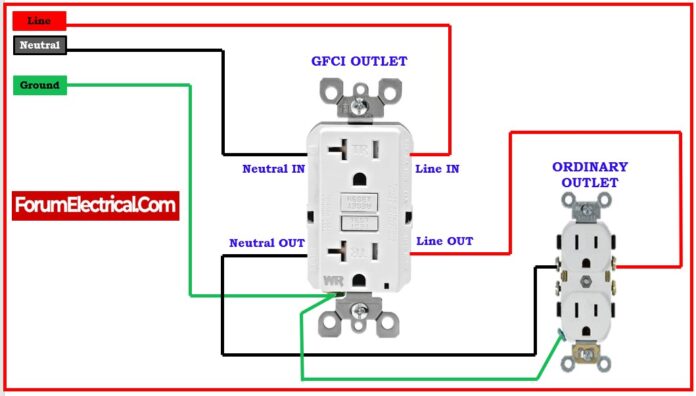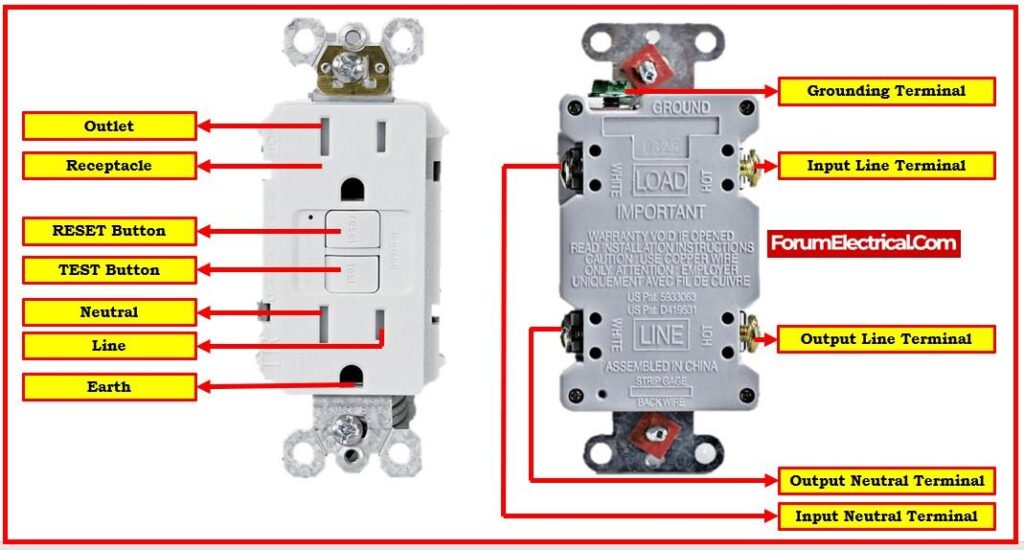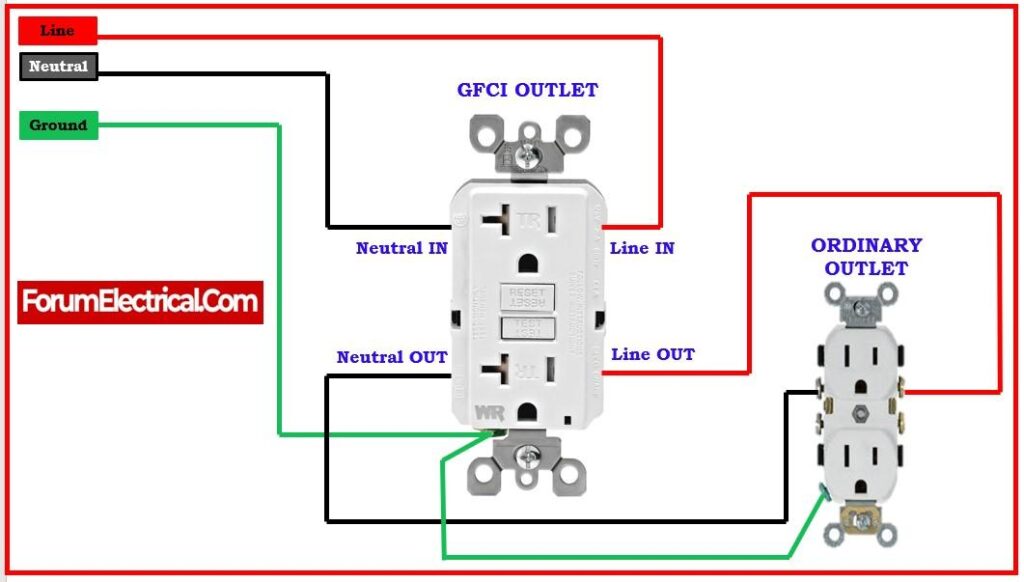- What does a ground fault mean?
- What is meant by a GFCI?
- How Does GFCI Work?
- Diagram of GFCI Outlet Wiring & Connection
- GFCI Connection to an Ordinary Outlet
- GFCI Types
- How can GFCI be tested?
- When should GFCI be tested?
- When & where should GFCIs be employed?
- What is GFCI fault (nuisance) tripping?
- GFCI – NEC Code Requirements
- GFCI Applications
What does a ground fault mean?
A conducting connection whether planned or unintentional between any electric conductor & any conducting product that is grounded or has the potential to become grounded is referred to as a “ground fault” in the National Electrical Code.
Electricity is continually looking for a path to reach the ground. A ground fault occurs when electricity finds a way to ground that it was never intended to take, such as over a person’s body.
Because of this risk of shock, GFCI protection is utilized to save human life.
What is meant by a GFCI?
A ground fault circuit interrupter (GFCI) is useful in the prevention of electrocution. If a person’s body starts getting a shock, the GFCI detects it and shuts off the electricity before he or she is damaged.
GFCIs are typically installed in areas where electrical circuits can come into connection with water by accident. They are most commonly seen in kitchens, bathrooms, and laundry rooms, but they can also be located outside or in the garage if electric power tools are utilized.
As a safety precaution, it is a specific electrical receptacle (or) outlet that may cut power within milliseconds.
It trips electrical circuits when it detects ground faults (or) leakage currents.
In general, GFCIs are utilized wherever there is a risk of contact between a human and an electrical item in (or) near moisture, water, (or) water pipes.
GFCIs are especially handy for corded appliances & equipment used outdoors (or) near water.
How Does GFCI Work?
A standard electrical outlet typically has two vertical slots & a round hole beneath them. The larger “left slot” correlates to “neutral,” whereas the smaller “right slot” corresponds to “hot or line.” The “ground” is the third-round hole.
In a normal outlet, electricity flows from hot to neutral. The GFCI compares the current leaving the hot (live) side of the power source to the current returning to the neutral side.
If they are unequal, it signifies that a percentage of the current is going in an unexpected direction, potentially through water or a person.
The GFCI detects an imbalance in the current traveling from hot to neutral & instantly cuts off electricity, lowering the possibility of electrical shock.
The sensor inside a GFCI monitors the difference between current flowing to and current flowing from the appliances.
If the current flowing into the circuit differs from the current returning by as little as 4 or 5 milliamps, a GFCI immediately shuts down every source of power by tripping a relay inside it within a few hundreds of a second, considerably before the user feels the shock.
After the problem has been resolved, GFCIs can be reset to restore power to the damaged circuit.
If the problem persists and the GFCI continues to “sense” the difference between the quantity of electricity flowing into and out of the circuit, it will not reset.
Diagram of GFCI Outlet Wiring & Connection
The input, output, line, and load terminals of a GFCI outlet can be seen in the statement above.
Earthing, also known as grounding, is performed with the largest blade inside the outlet. The narrow blade on the upside-right is for line, phase, or hot. The wide blade on the top left is for neutral.
The upside left terminal of the receptacle is for input neutral, while the up-side right terminal is for input live (or) phase terminal. The left connector on the bottom is for neutral out (or) output to an external load. The down-side terminal is responsible for earthing (or) grounding.
The phase terminals are often constructed of brass screws, whereas the neutral terminals are composed of silver screws.
Ex: If, GFCI was installed six months (or) a year ago. As a result, must ensure that it is operational.
From the above picture may view the connection between the GFCI and the input power supply.
- Connect the phase terminal, also known as the live terminal, of the electric power source to the terminal that is oriented upside-right on the outlet.
- Make the connection between the neutral terminal of the electricity source and the terminal that is located on the top left of the outlet.
- Attach the earthing (or grounding) wire to the bottom terminal of the outlet by following the directions on the wiring diagram, that are located above.
- At this point, once the power connection has been finished, can able to attach any device to the GFCI Outlet. The device will get power from the GFCI outlet, & it will be protected from ground faults.
GFCI Connection to an Ordinary Outlet
The GFCI outlet contains output terminals that can be utilized to connect external outlets (or) loads. When connect any load (or) conventional outlet to the GFCI outlet’s output, it will be additionally ground fault protected.
One may protect any appliances or equipment plugged into that outlet by connecting the regular outlet to the GFCI outlet. Although only one outlet is shown here, numerous outlets can be connected in parallel.
- Connect all of the input power supply terminals as described in the previous step.
- Connect the GFCI outlet’s downside right terminal to the conventional outlet’s upside right terminal.
- Connect the GFCI outlet’s underside left terminal to the conventional outlet’s upside left terminal.
- Make a loop (or) connect the earthing between the GFCI outlet and the regular outlet. Users can also attach an external earthing (or) grounding system.
GFCI Types
In most applications, three types of GFCIs are used:
- GFCI outlet,
- GFI circuit breaker, and
- Portable GFCI.
Although all of these GFCIs accomplish the same function, their applications and limitations differ.
GFCI outlet
It functions similarly to a regular electrical socket and protects any device that is connected into it. It is also possible to wire the GFCI outlet so that it protects any additional outlets that are linked to it.
GFI Circuit Breaker
It manages and protects a complete circuit and is inserted in a house’s main circuit board as an alternative for a regular circuit breaker. Unlike several GFCI outlets, a single GFCI circuit breaker can protect the whole circuit, which could include all bathrooms (or) all outdoor fixtures.
Precautions: The GFCI circuit breaker is required to be compatible with the standards of the main electrical panel. GFCI outlets should be utilized alternatively of a GFCI circuit breaker on an older panel that employs fuses.
Portable GFCI
It is utilized for mobile applications & is equally effective as those placed in a residence. Contractors routinely utilize portable GFCIs on construction sites. However, portable GFCI protection could be employed whenever electrically powered equipment is used in gardening or when utilizing electric tools in & around the house.

Precautions: Portable GFCIs are not to be utilized in place of permanent one in the house. They are only to be utilized when need to bring power from an unsecured outlet into an unsafe condition.
How can GFCI be tested?
Many people do not test their GFCIs to ensure they are operational. GFCIs are electronic devices that may get damaged or worn down over time. Even if the GFCI circuit is no longer operational, the electrical receptacle in the GFCI can still function. If this is the condition, contact a certified electrician as soon as possible.
When should GFCI be tested?
In order to verify that GFCIs are operating correctly, they need to be inspected on a monthly basis.A portable GFCI should be utilized outdoors with different electrical power tools (such as drills, mowers, and trimmers) and tested before each usage.
When & where should GFCIs be employed?
It is advised to install GFCIs in locations where appliances & power tools are utilized in close contact to water. Tap water or moist things can easily conduct electricity and attach the body to a ground potential, increasing the risk of suffering a ground fault shock. Appliances with built-in GFCI protection, such as hair dryers, may not require additional GFCI protection, although there are still numerous appliances that do not have GFCI protection.
What is GFCI fault (nuisance) tripping?
A GFCI can trip with less as 5 mA (0.005 A) of electricity leaking from the hot (live) wire to the ground. It could be challenging to prevent a tiny amount of leakage current in certain typical circuits. When properly maintained, hand-held power tools don’t lead to tripping hazards. Certain stationary motors, like those found in fluorescent light fixtures or bathroom vent fans, may leak enough to trigger annoyance trips. A lengthy circuit with numerous splices could be another problem. Make sure that GFCI circuits are no longer than 100 feet. In order to prevent annoying tripping, a GFCI shouldn’t provide:
- Circuits more than one hundred feet,
- Lighting fixtures with electric discharge, such as fluorescent (or) other types,
- Permanent electric motors fitted.
GFCI – NEC Code Requirements
The NEC Code Requirements for the GFCIs are designed to protect everyone who connects to an electrical system. The NEC Code requires the installation of the GFCIs in the following areas:
- 210.8(A) – Dwelling Units
- 406.3(D)(2), (3) – Receptacle Replacement
- 424.44(G) -Electric Space Heating Cables
- 511.12 – Commercial Garages
- 517.20(A) – Healthcare Facilities
- 525.23 – Carnivals, Circuses, & Fairs
- 527.6 – Temporary Installations
- 547.5(G) – Agricultural Buildings
- 555.19 – Marinas and Boatyards
- 680.32 – Swimming Pools& Storable
- 680.62 – Therapeutic Tubs
- 680.71 – Hydromassage Bathtubs
- 620.23, 620.85 – Elevators & Escalators
- 680.43, 680.44 – Spas & Hot Tubs
- 680.22(A), 680.23, 680.27 – Swimming Pools& Permanent
- 680.51(A), 680.56(A), 680.57 – Fountains
GFCI Applications
GFCIs are typically installed in areas where water and electricity are present, such as the kitchen, garage, bathroom, basement, & outdoors. They are especially beneficial for corded appliances & equipment used outside or near water.
GFCIs to be connected in the following locations both inside and outside the house:
- Outdoor Receptacles for Underwater Pool Lighting
- Toilet Receptacles
- Receptacles in the Garage
- Receptacles in the Kitchen
- Crawl Areas
- Basements that are unfinished
- Sinks for Wet Bars
- Laundry Containers
- Sinks for utensils














